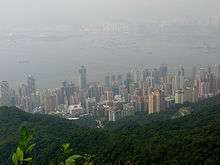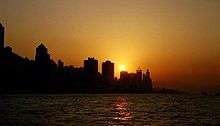Sai Wan
| Sai Wan | |||||||||||
 | |||||||||||
| Traditional Chinese | 西環 | ||||||||||
|---|---|---|---|---|---|---|---|---|---|---|---|
| Simplified Chinese | 西环 | ||||||||||
| Literal meaning | West Ring | ||||||||||
| |||||||||||

Sai Wan (Chinese: 西環, Western District or simply Western) is an area in Hong Kong Island, Hong Kong that corresponds to Sai Ying Pun, Shek Tong Tsui, Belcher Bay and Kennedy Town. However, Some Hong Kong people consider Kennedy Town as the only part of Sai Wan. It formed part of the City of Victoria. West Point, a former cape where major government structures in Sai Wan are close to, also used to refer to Sai Wan.
History
History of Sai Ying Pun
In the early 1800s, Sai Ying Pun was known as a place to settle the Chinese immigrants. It was built from the west of Tai Ping Shan. Europeans were also assigned to live in the same area. Yet, they were separated at the High Street where Chinese were excluded from living.
In 1880, sewerage was installed into the are, with the main flow coming down Centre Street. Streets were covered with macadam and concreted at the same time.
In 1890s, a severe epidemic outbreak named bubonic plague afflicted Sai Ying Pun residents. Sheung Fung Lane residents were almost wiped out during the period.[1] Government Reports identified this area as the no. IX health district and went into great detail about the buildings where the disease occurred. The neighboring area, Tai Ping Shan, was the most infected place in the city. It was resumed, abandoned and demolished to improve hygiene as well
History of Shek Tong Tsui
The name of Shek Tong Tsui derived from a famous ancient stone pond, "Shek Tong" (石塘) in Cantonese, inside the area. The stone pond was located at modern-day Hill Road and The Belcher's, and was mined by the Hakka people since the 17th century.
In 1903, the first land reclamation of Shek Tong Tsui was finished. In the meantime, the largest brothels in the city, which were located at the Possession Street, were destroyed by a big fire. Consequently, Hong Kong Governor Matthew Nathan decided to move all Hong Kong Island's brothels to Shek Tong Tsui in the early 1900s due to the large area recently claimed from the land reclamation. The place was then being well flourished as a red light district and came to its golden period. Numerous Cantonese opera theaters and restaurants were founded because of the business of brothels. It was the best place to entertain the affluent Chinese in Hong Kong.[2]
Queen's Road was the first road built in Hong Kong, constructed by the British from 1841 to 1843.[3] It connected the Victoria City from Shek Tong Tsui to Wan Chai.
Brothels in this area had also inspired numerous novels and Hong Kong films, most notably Rouge (1987), starring Anita Mui and Leslie Cheung.
History of Belcher Bay
Belcher bay was named after Edward Belcher who landed on Possession Point at the north shore Hong Kong Island and made the first British survey of Hong Kong harbour on the 25th January 1841.
Belcher Bay, Gin Drinkers Bay and Tseung Kwan O were known as the 'Bay of Trash' in Hong Kong.
Belcher's Street is the main street in Kennedy Town of Hong Kong. It connects the Victoria Road and Queen's Road West. A small section in its west end built a turn around for Hong Kong Tramway.
It is currently used as a site for ships to load and unload goods.
History of Kennedy Town
Kennedy Town was the western section of the historical Victoria City. It was named after the governor Arthur Edward Kennedy who iniated the lane reclamation alogn the coast of this area in 1886. It formed a narrow coastal strip of land that included the Kennedy Praya and the coastal area from Beach Street via Collinson Street to Shek Tong Tsui.[4][5]
In 1903, the Hong Kong Government erected seven boundary stones for the city, inscribed "City Boundary 1903". One of them is located at the Kennedy Town Temporary Recreation Ground at Sai Ning Street (西寧街).
From 1933 to 1939, more land was reclaimed along the coast of Kennedy Town, yet the construction was suspended due to the Battle of Hong Kong in 1941. Another land reclamation was conducted recently at the end of the 20th century.
Historial Buildings, Landmarks
- Lo Pan Temple, a Grade I historic building
- Elliot Pumping Station & Filters Senior Staff Quarters,[8] No. 77 Pok Fu Lam Road, a Grade II historic building
- Elliot Pumping Station & Filters Workmen's Quarters, a Grade III historic building
- Elliot Pumping Station & Filters, Treatment Works Building, a Grade III historic building
- Ex-Western Fire Station, No. 12 Belcher's Street, a Grade III historic building. Converted into the Po Leung Kuk Chan Au Big Yan Home for the Elderly
- Sai Ying Pun Community Complex
- University of Hong Kong
- China Merchants Group The Westpoint
- Sai Wan Harbour
- Ching Lin Terrace
- Kwun Lung Lau
| Wikimedia Commons has media related to Sai Wan. |
Coordinates: 22°17′06″N 114°07′55″E / 22.285°N 114.132°E
References
- ↑ Pryor, E.G. (1975). "The Great Plague of Hong Kong" (PDF). Journal of the Hong Kong Branch of the Royal Asiatic Society. Hong Kong: Royal Asiatic Society of Great Britain and Ireland-Hong Kong Branch. 1975: 69.
- ↑ http://www.eac.gov.hk/pdf/distco/2007dc/dc2007a.pdf
- ↑ Lim, Patricia Pui Huen (2002). Discovering Hong Kong's Cultural Heritage: Hong Kong Island and Kowloon. Oxford University Press. p. 10. ISBN 9780195927238.
- ↑ Consultancy Agreement No. NEX/1023. West Island Line Environmental Impact Assessment. Final Environmental Impact Assessment Report. Appendix 6.1: "Reclamation History", May 2008
- ↑ Kwok, Ka-chun, Peter, "Remodelling U.C. Complex in Kennedy Town", University of Hong Kong, 1995